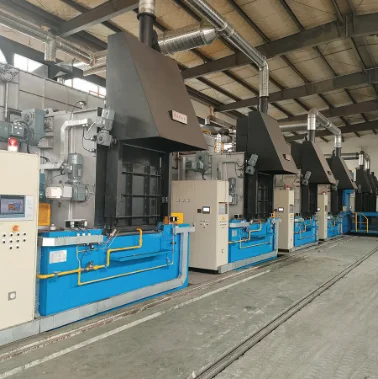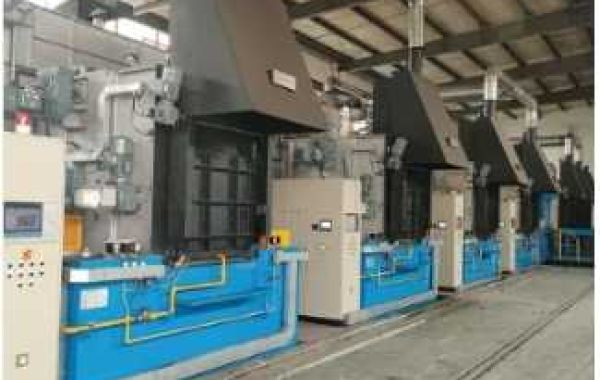Welcome to the fascinating world of aerospace engineering, where innovation and precision take flight! In this high-tech industry, every component plays a crucial role in ensuring optimal performance and safety. One such essential element is atmosphere furnaces. These remarkable machines bring heat-treating capabilities to new heights, enabling the aerospace industry to achieve unparalleled quality and durability in their materials. Join us as we delve into the role of atmosphere furnaces and how they revolutionize the way aircraft are built and maintained. So fasten your seatbelts, because we're about to soar through an exploration of these extraordinary devices that make aerospace dreams come true!
What are atmosphere furnaces?
Atmosphere furnaces, also known as controlled atmosphere furnaces, are specialized heating systems used in various industries, including aerospace. These sophisticated machines create a precise environment for heat treatment processes such as annealing, tempering, and hardening of metals.
The key feature of an atmosphere furnace lies in its ability to manipulate the surrounding atmosphere within the chamber. By carefully controlling factors like temperature, pressure, gas composition (such as nitrogen or argon), and humidity levels inside the furnace, manufacturers can achieve specific material properties desired for aerospace applications.
Equipped with advanced sensors and controllers, atmosphere furnaces ensure uniform heat distribution throughout the entire workpiece. This consistency is crucial to prevent distortion or warping during the heat-treating process.
In addition to maintaining a controlled environment, these furnaces often incorporate features like rapid cooling systems to expedite production cycles without compromising material quality. This not only saves valuable time but also enhances overall efficiency in aerospace manufacturing.
Moreover, modern atmosphere furnaces come with programmable logic controllers (PLCs) that allow operators to set precise parameters for each heat treatment cycle. This level of customization ensures repeatability and enables manufacturers to meet stringent industry standards consistently.
With their versatility and adaptability across multiple materials like steel alloys and titanium alloys commonly used in aircraft components - from landing gear parts to turbine blades - it's no wonder why atmosphere furnaces have become invaluable assets in the aerospace industry.
The features of Atmosphere furnace
Atmosphere furnaces, like those manufactured by Jiangsu Weixin Heat-Treating Facility Co.,Ltd., are essential tools used in various industries, including the aerospace sector. These advanced furnaces offer a range of impressive features that make them highly efficient and reliable for heat treatment processes.
One notable feature of atmosphere furnaces is their precise temperature control capability. This ensures that the desired temperature is consistently maintained throughout the entire heat treatment process. The ability to maintain precise temperatures is crucial for achieving uniformity and consistency in parts or components being treated.
Another important feature of atmosphere furnaces is their gas circulation system. These furnaces have specially designed systems that allow for controlled gas flow, ensuring optimal distribution within the furnace chamber. This helps create an ideal environment for various heat treatment processes, such as carburizing or nitriding, where specific gases are required.
Additionally, atmosphere furnaces often come equipped with programmable controllers that allow operators to easily set and adjust parameters such as temperature profiles and holding times. This level of automation simplifies operation while also providing accurate monitoring and control over the entire process.
Furthermore, modern atmosphere furnaces are designed with safety features in mind. They incorporate advanced insulation materials to minimize heat loss and reduce energy consumption. Additionally, these furnaces often have built-in alarms and fail-safe mechanisms to protect against any potential hazards during operation.
Atmosphere furnaces offer a range of impressive features that make them invaluable in the aerospace industry's heat treatment processes. Their precise temperature control capabilities, gas circulation systems, programmable controllers, and safety features ensure efficient operations while maintaining high-quality standards demanded by this demanding industry.

How are atmosphere furnaces used in the aerospace industry?
Atmosphere furnaces play a crucial role in the aerospace industry by providing controlled heat treatment environments for various components and materials used in aircraft manufacturing. These furnaces are designed to maintain specific atmospheric conditions, such as temperature, pressure, and gas composition, to achieve desired material properties.
One of the primary applications of atmosphere furnaces in the aerospace industry is for annealing processes. Annealing involves heating a metal or alloy to a specific temperature and then slowly cooling it, which helps relieve internal stress and enhance its mechanical properties. This is particularly important for critical aerospace components that need to withstand extreme conditions.
Another common use of atmosphere furnaces in aerospace is for hardening and tempering processes. Hardening involves heating the material above its critical transformation temperature and rapidly quenching it using gases like nitrogen or argon. This results in increased hardness and strength while maintaining good ductility.
In addition to these heat treatment processes, atmosphere furnaces are also used for brazing operations in aerospace manufacturing. Brazing involves joining two or more metal parts by melting a filler metal that has a lower melting point than the base metals being joined. The controlled atmosphere provided by these furnaces ensures clean surfaces free from oxidation during brazing.
The benefits of using atmosphere furnaces extend beyond just achieving desired material properties. These advanced furnace systems offer precise control over process parameters like temperature uniformity, ramp rates, cooling rates, and gas flow rates – factors that are crucial for ensuring consistent quality in aerospace manufacturing.
In conclusion, atmosphere furnaces have revolutionized heat treatment processes within the aerospace industry.
The benefits of using atmosphere furnaces in the aerospace industry
Atmosphere furnaces play a crucial role in the aerospace industry, offering a range of benefits that contribute to the production of high-quality components and materials. One key advantage is their ability to create controlled atmospheres during heat treatment processes. This ensures that parts are treated in an environment specifically tailored to meet the desired properties, such as improved strength, durability, or resistance to corrosion.
Another benefit of atmosphere furnaces is their versatility. They can accommodate a wide variety of materials commonly used in aerospace applications, including steel alloys, titanium alloys, and superalloys. The precise control over temperature and atmospheric conditions allows for consistent and repeatable results across different batches of parts.
Furthermore, atmosphere furnaces offer excellent uniformity throughout the heat treatment process. This means that all areas of a component experience similar thermal profiles and are subjected to the same chemical reactions. As a result, material distortion and warping are minimized, leading to parts with tight tolerances and dimensional accuracy.
The use of atmosphere furnaces also contributes to improved efficiency in aerospace manufacturing operations. By optimizing process parameters such as heating rates and cooling rates, manufacturers can reduce cycle times without compromising quality. Additionally, these furnaces often feature advanced automation capabilities which streamline workflow management and enhance productivity.
Atmosphere furnaces provide numerous advantages for the aerospace industry – from creating controlled environments for optimal material properties to enhancing manufacturing efficiency through automation.

Conclusion
Atmosphere furnaces play a crucial role in the aerospace industry by providing precise and controlled heat-treating processes for various components and materials used in aircraft manufacturing. These specialized furnaces, such as those offered by Jiangsu Weixin Heat-Treating Facility Co., Ltd., offer unique features that make them ideal for aerospace applications.
The ability of atmosphere furnaces to create specific atmospheric conditions ensures the desired properties of aerospace materials are achieved. By controlling factors such as temperature, pressure, and gas composition within the furnace chamber, these furnaces enable precise modifications to the structure and properties of metals, alloys, composites, and other materials.
Through processes like annealing, carburizing or nitriding, atmosphere furnaces can enhance the strength, hardness, wear resistance or corrosion resistance of aerospace components. This is particularly important for critical parts like turbine blades or landing gear systems that need to withstand extreme operating conditions while maintaining optimal performance.
Moreover, using atmosphere furnaces provides several benefits to the aerospace industry. The uniform heating capabilities ensure consistent results across large batches of parts or even complex geometries. This not only saves time but also reduces production costs associated with rejections or rework due to inconsistent heat treatment.
Additionally, atmosphere furnaces offer excellent temperature control accuracy and stability throughout the entire process. This precision eliminates any risk of thermal distortion or damage to sensitive components during heat treatment.
Furthermore, these advanced furnaces provide enhanced safety features including automatic monitoring systems that continuously track critical parameters like temperature levels or gas flow rates. This helps prevent any potential hazards during operation and guarantees a safe working environment for operators.
Overall,the role played by atmosphere furnaces cannot be overstated in ensuring high-quality aerospace products are manufactured efficiently and reliably.
To explore more about how Jiangsu Weixin Heat-Treating Facility Co.,Ltd.'s atmosphere furnaces can elevate your manufacturing capabilities within the aerospace industry,contact our team today!







